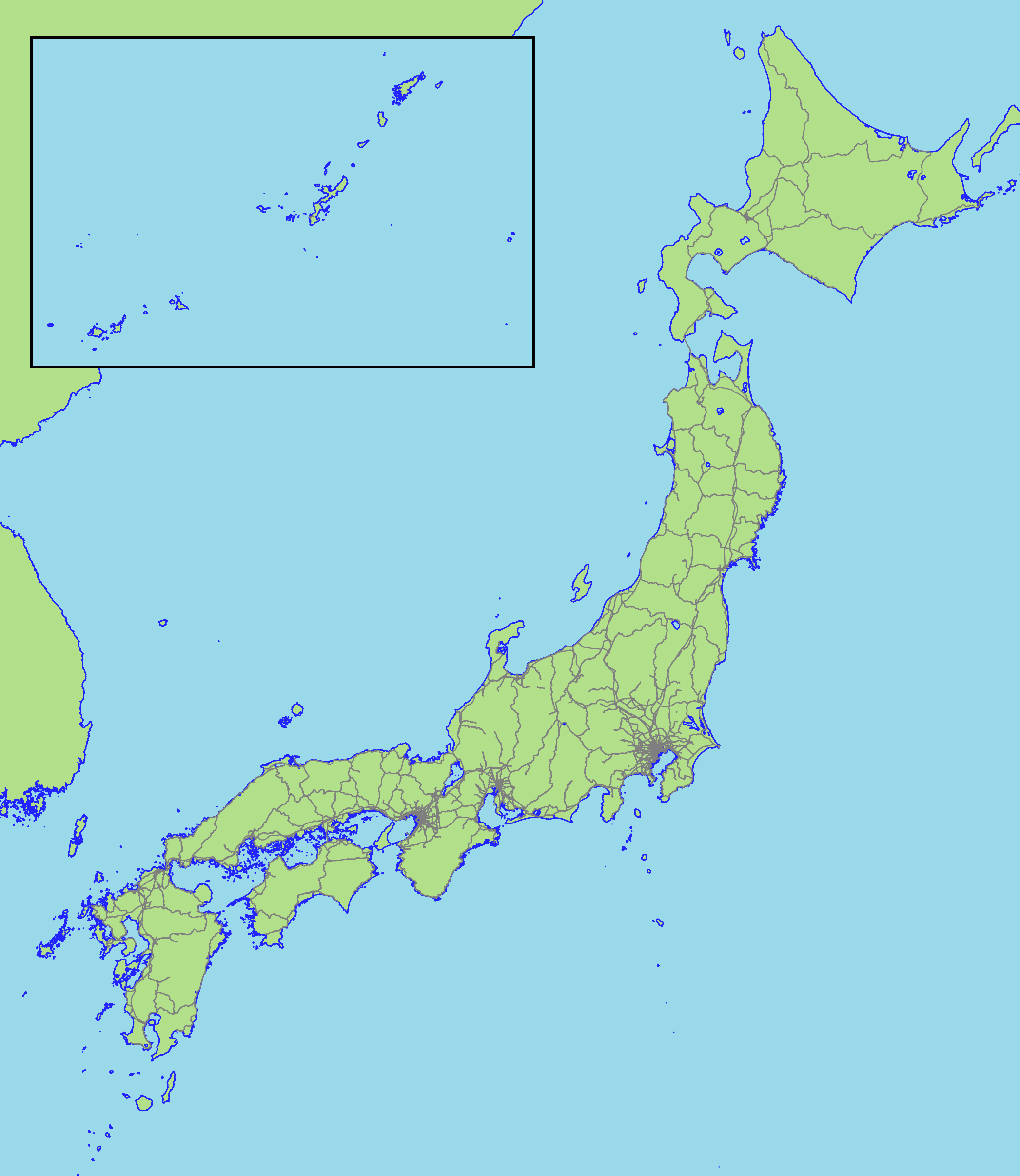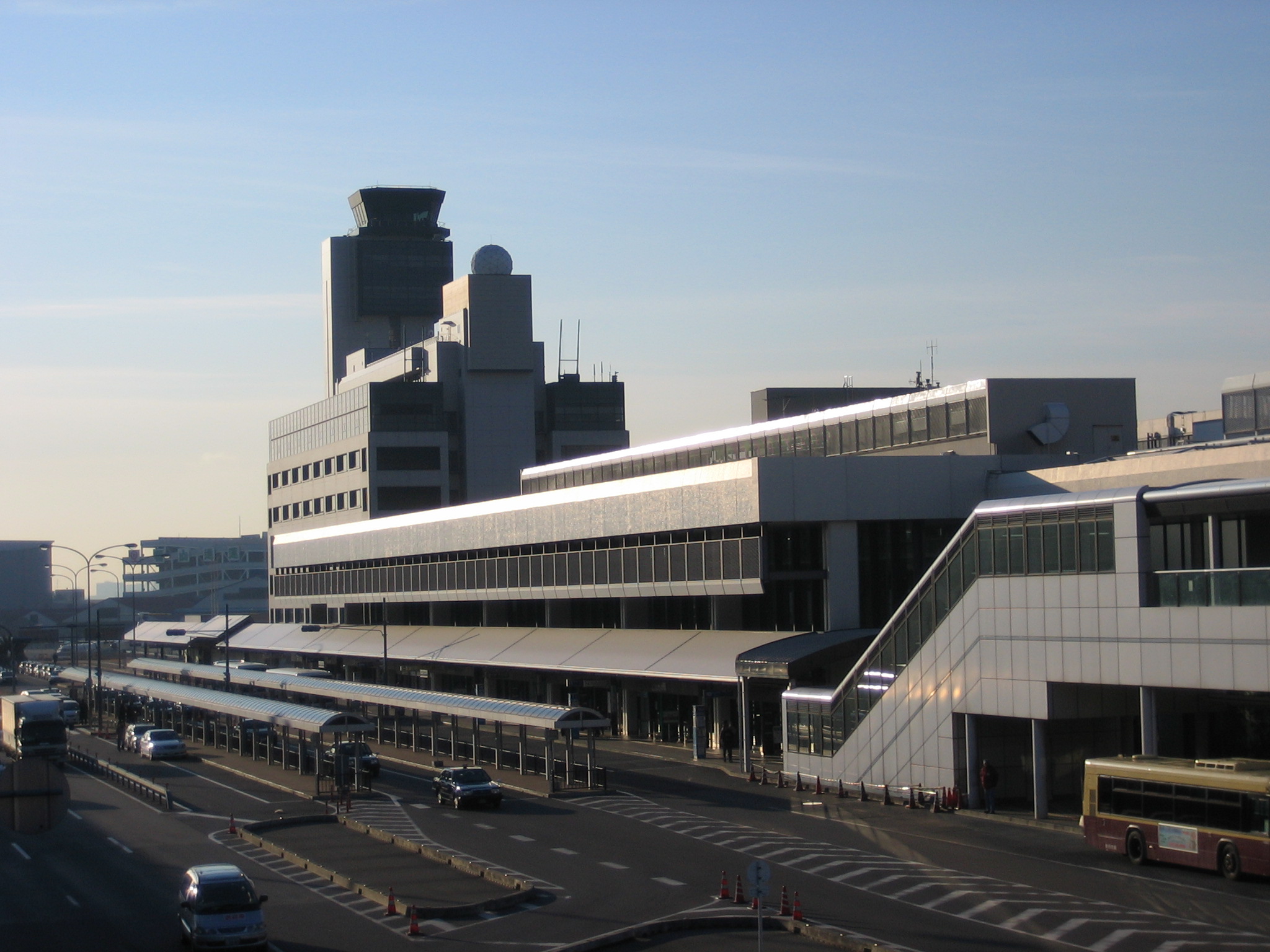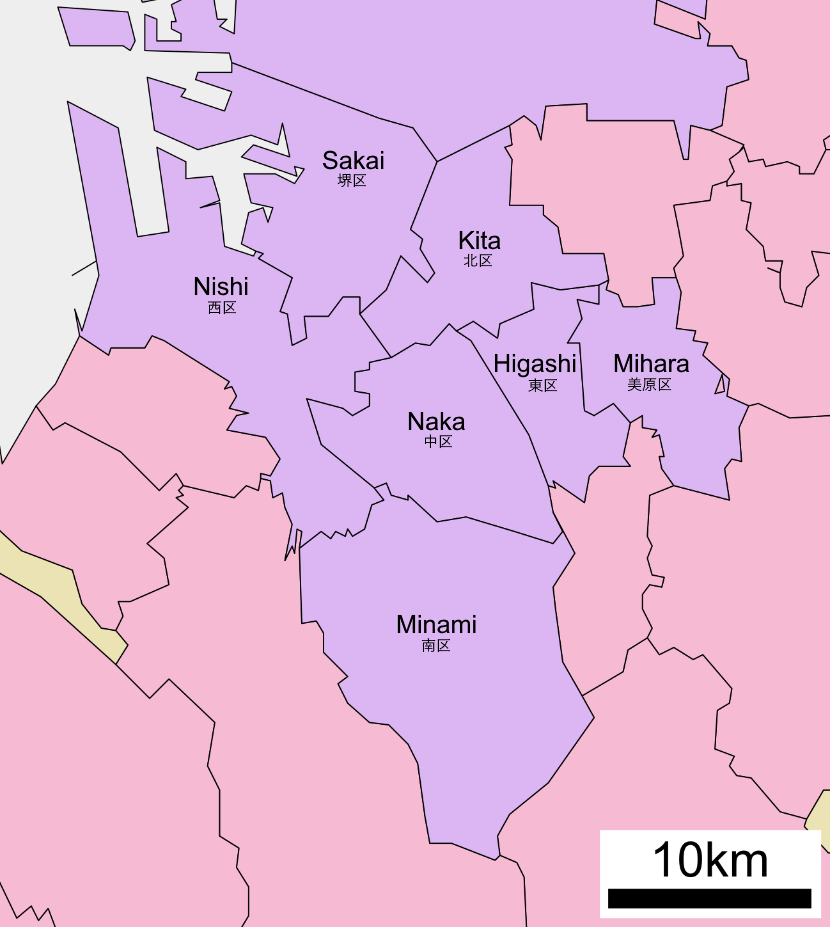|
Osaka Municipal Subway
The is a major rapid transit system in the Osaka Metropolitan Area of Japan, operated by the Osaka Metro Company, Ltd. It serves the city of Osaka and the adjacent municipalities of Higashiosaka, Kadoma, Moriguchi, Sakai, Suita, and Yao. Osaka Metro forms an integral part of the extensive mass transit system of Greater Osaka (part of the Kansai region), having 123 out of the 1,108 rail stations (2007) in the Osaka-Kobe-Kyoto region. In 2010, the greater Osaka region had 13 million rail passengers daily (see Transport in Keihanshin) of which the Osaka Municipal Subway (as it was then known) accounted for 2.29 million. Osaka Metro is the only subway system in Japan to be legally classified as a tramway, whereas all other subway systems in Japan are legally classified as railways. Despite this, it has characteristics typical of a full-fledged metro system. Overview The network's first service, the Midōsuji Line from to , opened in 1933. As a north–south trunk rout ... [...More Info...] [...Related Items...] OR: [Wikipedia] [Google] [Baidu] |
Midōsuji Line
The is a rapid transit line in Osaka, Japan, operated by Osaka Metro. Constructed under Midōsuji, a major north-south street, it is the oldest line in the Osaka subway system and the second oldest in Japan, following the Tokyo Metro Ginza Line. Its official name is , while the Osaka Municipal Transportation Bureau refers to it as , and in MLIT publications it is referred to as . On line maps, stations on the Midōsuji Line are indicated with the letter "M". North of Nakatsu it runs above ground in the median of ''Shin-midōsuji'', an elevated freeway. The section between and is owned and operated by , but is seamless to the passengers except with respect to fare calculations. In June 2018, the Midosuji line is the most congested railway line in the Kansai region of Japan, at its peak running at 151% capacity between Umeda and Yodoyabashi stations. Line data * Above-ground section: north of Nakatsu to Esaka; Esaka to south of Senri-Chūō (Kita-Osaka Kyuko Railway) * ... [...More Info...] [...Related Items...] OR: [Wikipedia] [Google] [Baidu] |
Rapid Transit System
Rapid transit or mass rapid transit (MRT), also known as heavy rail or metro, is a type of high-capacity public transport generally found in urban areas. A rapid transit system that primarily or traditionally runs below the surface may be called a subway, tube, or underground. Unlike buses or trams, rapid transit systems are railways (usually electric railway, electric) that operate on an exclusive right-of-way (transportation), right-of-way, which cannot be accessed by pedestrians or other vehicles, and which is often grade-separated in tunnels or on elevated railways. Modern services on rapid transit systems are provided on designated lines between rapid transit station, stations typically using electric multiple units on rail tracks, although some systems use guided rubber tires, magnetic levitation (''maglev''), or monorail. The stations typically have high platforms, without steps inside the trains, requiring custom-made trains in order to minimize gaps between train a ... [...More Info...] [...Related Items...] OR: [Wikipedia] [Google] [Baidu] |
Tram
A tram (called a streetcar or trolley in North America) is a rail vehicle that travels on tramway tracks on public urban streets; some include segments on segregated right-of-way. The tramlines or networks operated as public transport are called tramways or simply trams/streetcars. Many recently built tramways use the contemporary term light rail. The vehicles are called streetcars or trolleys (not to be confused with trolleybus) in North America and trams or tramcars elsewhere. The first two terms are often used interchangeably in the United States, with ''trolley'' being the preferred term in the eastern US and ''streetcar'' in the western US. ''Streetcar'' or ''tramway'' are preferred in Canada. In parts of the United States, internally powered buses made to resemble a streetcar are often referred to as "trolleys". To avoid further confusion with trolley buses, the American Public Transportation Association (APTA) refers to them as " trolley-replica buses". In the ... [...More Info...] [...Related Items...] OR: [Wikipedia] [Google] [Baidu] |
Rail Transport In Japan
Rail transport in Japan is a major means of passenger transport, especially for mass and high-speed travel between major cities and for commuter transport in urban areas. It is used relatively little for freight transport, accounting for just 0.84% of goods movement. The privatised network is highly efficient, requiring few subsidies and running with extreme punctuality. Overview Rail transport services in Japan are provided by more than 100 private companies, including * Six Japan Railways Group (JR) regional companies (state owned until 1987) which provide passenger services to most parts of Hokkaido, Honshu, Shikoku, and Kyushu; * The nationwide JR freight company; and * 16 major regional companies which provide railway services as part of their corporate operations. There are also dozens of smaller local private railways. Many of the private rail companies rank among the top corporations in the country. Railways were built by private corporations developing integrated ... [...More Info...] [...Related Items...] OR: [Wikipedia] [Google] [Baidu] |
Transport In Keihanshin
Transport in the Keihanshin metropolitan region is much like that of Tokyo: it includes public and private rail and highway networks; airports for international, domestic, and general aviation; buses; motorcycle delivery services, walking, bicycling, and commercial shipping. The nexus is in the central part of Osaka, though Kobe and Kyoto are major centers in their own right. Every part of Keihanshin has rail or road transport services. The sea and air transport is available from a limited number of ports for the general public. Public transport within Keihanshin is dominated by an extensive public system, beginning with an urban rail network second only to that of Greater Tokyo, consisting of over seventy railway lines of surface trains and subways run by numerous operators; buses, monorails, and trams support the primary rail network. Over 13 million people use the public transit system daily as their primary means of travel. Like Tokyo, walking and bicycling are much more commo ... [...More Info...] [...Related Items...] OR: [Wikipedia] [Google] [Baidu] |
Osaka-Kobe-Kyoto
is a metropolitan region in the Kansai region of Japan encompassing the metropolitan areas of the cities of Kyoto in Kyoto Prefecture, Osaka in Osaka Prefecture and Kobe in Hyōgo Prefecture. The entire region has a population () of 19,302,746 over an area of .Japan Statistics Bureau - "2015 Census", retrieved June 27, 2021 It is the second-most-populated urban region in Japan (after the ), containing approximately 15% of Japan's population. The [...More Info...] [...Related Items...] OR: [Wikipedia] [Google] [Baidu] |
Kansai
The or the , lies in the southern-central region of Japan's main island Honshū. The region includes the prefectures of Nara, Wakayama, Kyoto, Osaka, Hyōgo and Shiga, often also Mie, sometimes Fukui, Tokushima and Tottori. The metropolitan region of Osaka, Kobe and Kyoto (Keihanshin region) is the second-most populated in Japan after the Greater Tokyo Area. Name The terms , , and have their roots during the Asuka period. When the old provinces of Japan were established, several provinces in the area around the then-capital Kyoto were collectively named Kinai and Kinki, both roughly meaning "the neighbourhood of the capital". Kansai (literally ''west of the tollgate'') in its original usage refers to the land west of the Osaka Tollgate (), the border between Yamashiro Province and Ōmi Province (present-day Kyoto and Shiga prefectures).Entry for . Kōjien, fifth edition, 1998, During the Kamakura period, this border was redefined to include Ōmi and Iga Provinces. It i ... [...More Info...] [...Related Items...] OR: [Wikipedia] [Google] [Baidu] |
Transport In Greater Osaka
Transport (in British English), or transportation (in American English), is the intentional movement of humans, animals, and goods from one location to another. Modes of transport include air, land ( rail and road), water, cable, pipeline, and space. The field can be divided into infrastructure, vehicles, and operations. Transport enables human trade, which is essential for the development of civilizations. Transport infrastructure consists of both fixed installations, including roads, railways, airways, waterways, canals, and pipelines, and terminals such as airports, railway stations, bus stations, warehouses, trucking terminals, refueling depots (including fueling docks and fuel stations), and seaports. Terminals may be used both for interchange of passengers and cargo and for maintenance. Means of transport are any of the different kinds of transport facilities used to carry people or cargo. They may include vehicles, riding animals, and pack animals. Vehicles may i ... [...More Info...] [...Related Items...] OR: [Wikipedia] [Google] [Baidu] |
Yao, Osaka
is a city located in Osaka Prefecture, Japan. , the city had an estimated population of 263,436 in 126509 households and a population density of 6300 persons per km². The total area of the city is . The city is the birthplace of the Kawachi ondo style of folk singing. Geography Yao is locate adjacent to the central part of the Osaka Plain and southeast of Osaka metropolis. The west side of the city area is almost flat with an average elevation of only ten meters above sea level. The land rises in the east, with the Ikoma Mountains forming the prefectural border with Nara Prefecture. In addition to the Yamato River flowing at the southern end of the city, there are many small rivers. Neighboring municipalities Osaka Prefecture *Hirano-ku, Osaka * Higashiōsaka * Kashiwara * Fujiidera * Matsubara Nara Prefecture * Heguri * Sangō Climate Yao has a Humid subtropical climate (Köppen ''Cfa'') characterized by warm summers and cool winters with light to no snowfall. The ave ... [...More Info...] [...Related Items...] OR: [Wikipedia] [Google] [Baidu] |
Suita, Osaka
is a city located in northern Osaka Prefecture, Japan. As of October 1, 2016, the city has an estimated population of 378,322 and a population density of 9,880 persons per km². The total area is 36.11 km². The city was founded on April 1, 1940, and was the site of Expo '70, a World's Fair held in 1970. The J-League soccer club Gamba Osaka plays at Suita City Football Stadium. It is connected to central by Hankyu Railway, West Japan Railway Company and the Osaka Municipal Subway. The Osaka Monorail also passes through the area, connecting the city to Osaka, the Expo Commemoration Park and Osaka International Airport. Surrounding municipalities *Osaka Prefecture ** Osaka ( Yodogawa-ku, Higashiyodogawa-ku) ** Settsu ** Ibaraki ** Minoh ** Toyonaka Economy Major companies and industries * Asahi Suita Brewery * Headquarters of SNK, the producer of Neo Geo arcade boards and games * Mister Donut, a fast food franchise that offers doughnuts, coffee, muffins ... [...More Info...] [...Related Items...] OR: [Wikipedia] [Google] [Baidu] |
Sakai, Osaka
is a city located in Osaka Prefecture, Japan. It has been one of the largest and most important seaports of Japan since the medieval era. Sakai is known for its keyhole-shaped burial mounds, or kofun, which date from the fifth century and include Mozu Tombs, Daisen Kofun, the largest grave in the world by area. Once known for Katana, swords, Sakai is now famous for the quality of its Japanese kitchen knife, cutlery. , the city had an estimated population of 819,965, making it the fourteenth most populous city in Japan (excluding Tokyo). Geography Sakai is located in southern Osaka Prefecture, on the edge of Osaka Bay and directly south of the city of Osaka. Neighboring municipalities Osaka Prefecture *Osaka *Matsubara, Osaka, Matsubara *Habikino, Osaka, Habikino *Ōsakasayama, Osaka, Ōsakasayama *Kawachinagano, Osaka, Kawachinagano *Izumi, Osaka, Izumi *Takaishi, Osaka, Takaishi Climate Sakai has a Humid subtropical climate (Köppen ''Cfa'') characterized by warm summers and ... [...More Info...] [...Related Items...] OR: [Wikipedia] [Google] [Baidu] |
Moriguchi, Osaka
is a city located in Osaka Prefecture, Japan. , the city had an estimated population of 142,655 in 73353 households and a population density of 11,000 persons per km². The total area of the city is . Geography Moriguchi borders the northeastern part of Osaka City and faces the Yodo River on the north. It is formed in a "U" shape around Kadoma City. Originally, there were many low-lying areas and many lotus root fields, but the area is now almost completely urbanized. Surrounding municipalities Osaka Prefecture *Osaka (Higashiyodogawa-ku, Asahi-ku, Tsurumi-ku) * Settsu * Kadoma * Neyagawa Climate Moriguchi has a Humid subtropical climate (Köppen ''Cfa'') characterized by warm summers and cool winters with light to no snowfall. The average annual temperature in Moriguchi is 15.6 °C. The average annual rainfall is 1475 mm with September as the wettest month. The temperatures are highest on average in August, at around 27.7 °C, and lowest in January, at ... [...More Info...] [...Related Items...] OR: [Wikipedia] [Google] [Baidu] |









